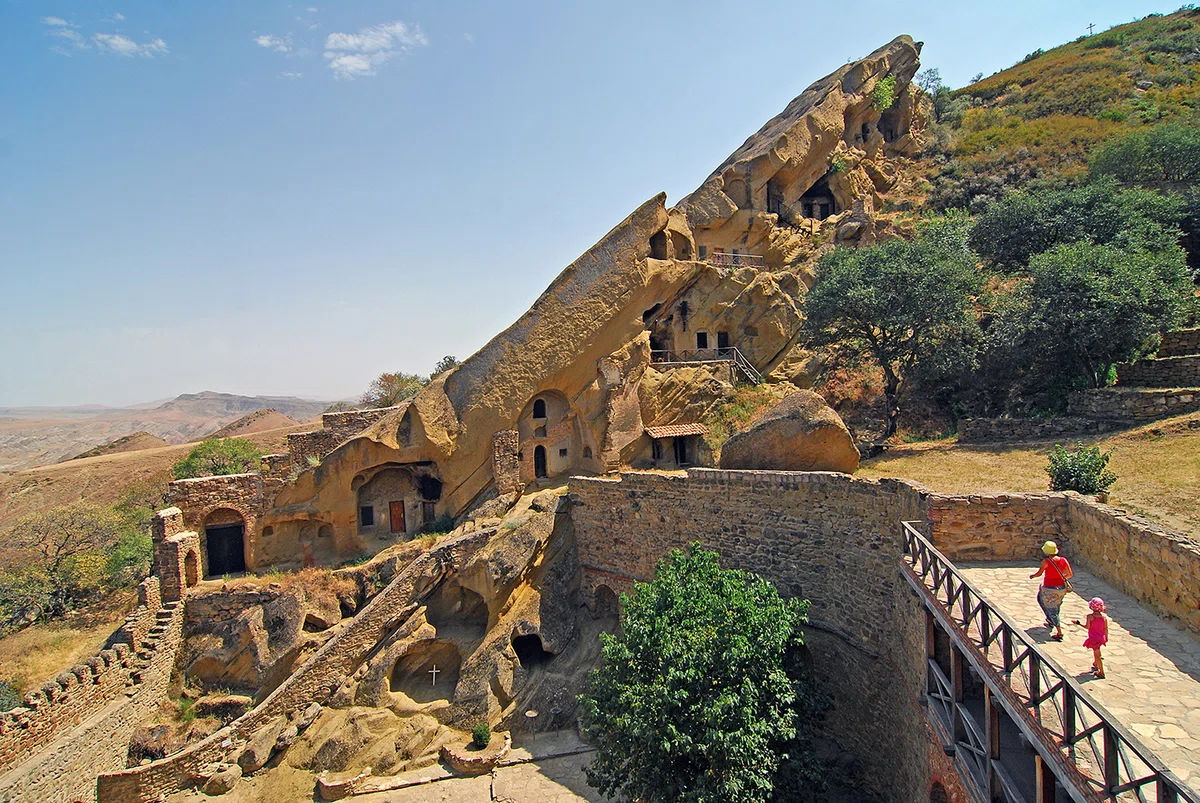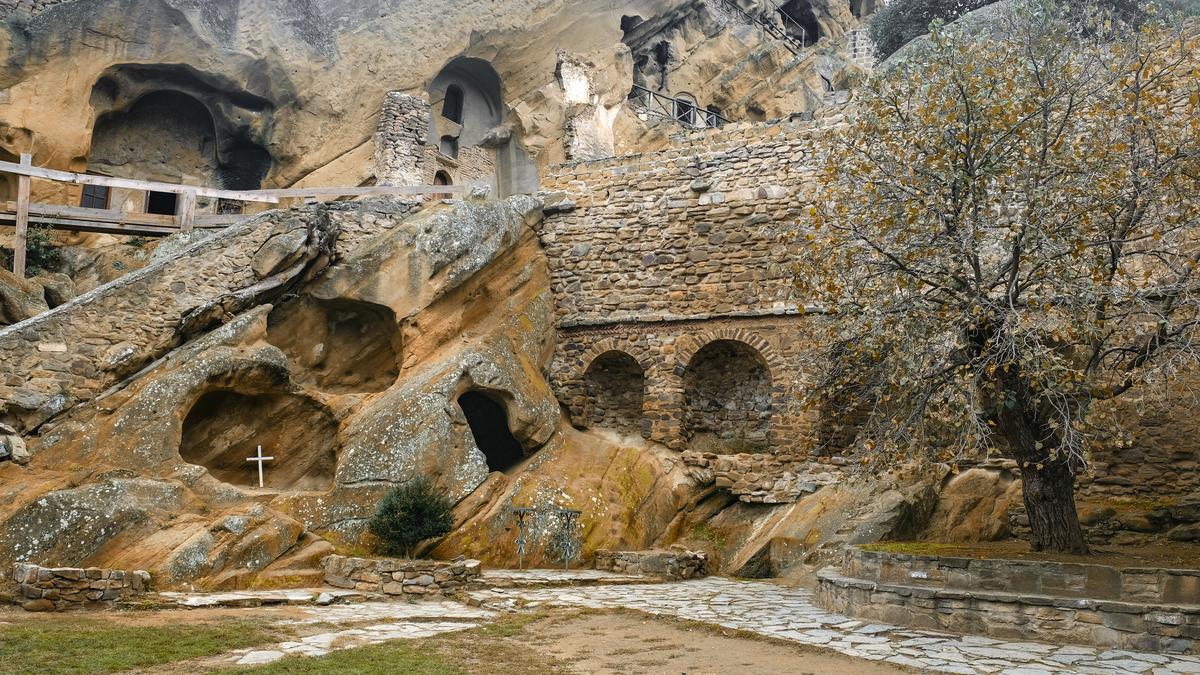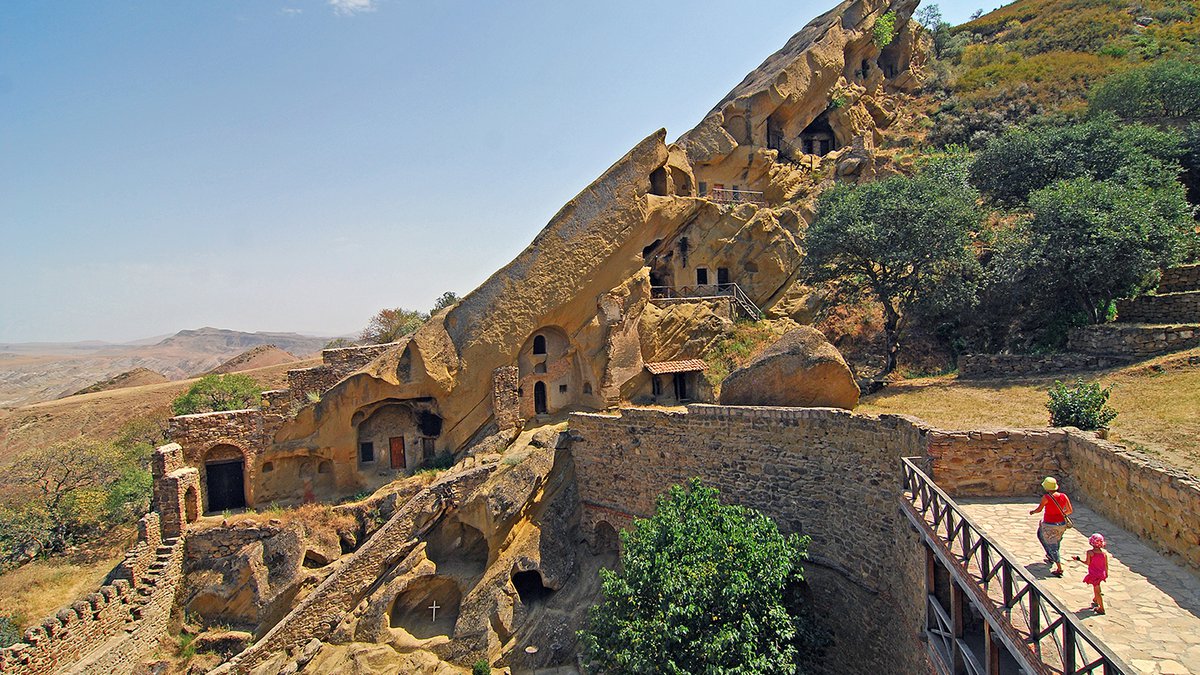
Founded by the 13th Assyrian Fathers, the Gareji Monastery is one of the most mysterious and beautiful places in Georgia.
The cave complex of the Gareji monastery is one of the main attractions of Georgia.
For those who want to see the most beautiful places of Georgia, this monument is a must-visit.
Sights of Georgia there are different types, but the monastery cave complex David Gareji is one of the most famous religious centers of the country. In addition to the spiritual part, history lovers will also have something to see here.
Location: Kakheti region, Sagarejo municipality. If you plan to get there by car, then you need to drive 60-70 km south-east of Tbilisi towards Gareji Hill.
This monastery is already of venerable age, because the date of its foundation is the 1st half of the 6th century. It was started by one of the 13 Assyrian fathers, David. This is the name of the founders of Georgian monasticism, who came to Georgia from Syria just in the 6th century and dispersed in different directions, becoming preachers. Accordingly, this place is especially revered by the locals.
But initially, David's plan did not include the construction of a huge monastery. It all started with the fact that he came to these places together with his disciple Lukian and settled in a cave. Actually, the monastery got the name of David Lavra later in honor of its founder.
From a small cave, a huge monastery began to grow, which reached such a size that it became the center of monastic life.
According to the data, the complex included as many as 12 monasteries, which is very symbolic for Christianity. But the scientist who studied Gareji G. Chubinashvili points out that the data available in the sources is enough only to get acquainted with 7 of them.
But another scientist Platon Ioseliani (a researcher of civil and ecclesiastical history of Georgia) went further in his research and described the remaining 11 monasteries of the complex: Bertubani, Verangareja, Dodo, Ioane Natlismtsemeli, Tetr-senakebi, Maghana or cave, Kolagori, Mohatuli and Pirukugmari, Chichkhituri, Tsamebuli.
The existence of some of them is also mentioned in the work of the Georgian poet Vakhtang VI, namely Lavra David, Bertubani, Dodo, Natlismtsemeli, Chichkhituri and Tsamebuli.
It is also mentioned that according to the administrative division of that period, the location of the monasteries was quite difficult, since they were located on the southern border of the region. Probably, this arrangement put the monastery in the first line of defense in case of attacks. This could be the reason that the network of cave passages formed quickly enough and covered a large area.
Returning to the importance of the monastery from a religious and cultural point of view, it is worth paying attention to the fact that at the beginning of the 12th century the whole David Gareji Monastery Complex it became the property of the royal family. It is likely that in this way David the Builder assisted in the development. One of the ways of support was that the monasteries were relieved of obligations to pay any state taxes.
At the same time, in the 12th-13th centuries, the peak of the construction of the monastery falls, which completely coincides with the cultural and political rise of Georgia.
It was then that the monastery developed a charter regulating monastic life, and also created a school of fresco painting.
And everything would be fine, only in 1265 Berke Khan, at the head of the Mongol army, carried out a raid and destroyed the monastery complex along with all its surroundings.
But over time, the complex was restored and in the first half of the 14th century, under the reign of Gregory V the Brilliant, it regained its lost positions as a leader of political and economic life. The proof is that the servants of the monastery exerted influence on the management of state and religious affairs of the country.
Such a life did not last long, and by the end of the same 14th century, due to the frequent raids of Tamerlane, monastic activity stopped here. And in the 1st half of the 15th century, namely in 1424, Emperor Alexander I handed over the monastery to the Patriarchal Svetitskhoveli Cathedral in Mtskheta.
A couple of centuries later, in 1616-1617, the Persians raided, which dealt a significant blow to monastic life in David Gareji. Everything returned to normal only in 1639 under the reign of Teimuraz I. Then not only the monastery itself was restored, but also the villages that were subordinate to the monks, and the inhabitants of these settlements were monastic servants. This life continued until the end of the 19th century.

Let's now look at the architecture in detail.
It is likely that belonging to the royal family, status position in the hierarchy influenced the image of the monasteries of the Gareji complex. There is no trace of traditional simplicity in the main rooms. The refectory and churches radiate majesty, scale and freedom. The impression of this scope is enhanced by the wall painting.
The walls are decorated with portraits of famous patrons and sponsors in the person of Georgian kings, such as Tamara and his son George IV, Demeter II the Self-Sacrificer and others.
Moreover, there are significantly more portraits of donors who have contributed to the development of the monastery than there are images of saints. This shows a departure from the traditions established in Byzantium.
The paintings highlight the faces, which are characterized by unusual dynamism and expressiveness in church painting. This is especially well represented in the scenes from the life of David Garejeli, which can be viewed in the central church.
And by the end of feudalism, the monasteries managed to be connected with checkpoints, as well as signal towers. Unfortunately, they have not survived to this day, only ruins remain.
But there is also something that has reached us through time. This is a plaster stucco of the 17th and 18th centuries on the walls of caves.
And it is not surprising that so many works of art have been preserved in the David Gareji complex, because Onofre Garejeli (12th century), Demeter I, Onofre Machutadze (17th-18th centuries), Sulkhan-Saba Orbeliani, Besarion Baratashvili-Orbelishvili, Nikoloz Cherkezishvili (18th century), Gabriel Saginashvili (18th century) worked here at one time., Grigol Dodorkelli, Anton I, Timote Gabashvili, Gabriel Mtsire and others. Each of them worked here on their scientific works, the creation of various collections. That is why the monastery was famous for its rich book fund.
You can read endlessly about this complex, but it's better to come and see. So, don't forget to add David Gareji to your "what to see in Georgia" list.













8 comments
Log in to leave a comment